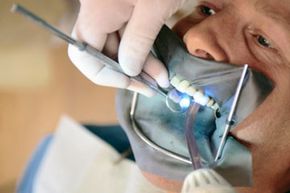When a beaver builds a natural dam or an engineer plans a man-made dam, both design the structures to control and hold back debris and water. Dams form barriers to unwanted elements in the environment; logs don't jam and block free-flowing streams, water doesn't flood areas meant to stay dry, and unwanted objects are kept from washing through and mucking up the waters. Dental dams act much the same way by controlling the flow of moisture and debris into and out of an open mouth. Unlike most built dams, however, those used in dentistry are temporary, disposable barriers.
A dental dam -- also called a rubber dam or intraoral dental dam -- is a square of latex or non-latex material that fits into the mouth and covers all but the teeth being worked on during a dental visit. One way to envision a dental dam is to think of painter's tape. You tape off areas like the crown and base molding to protect them from dripping paint and stray brush strokes. Using a dental dam is similar because it covers a patient's oral opening, keeping their cheeks, tongue and surrounding teeth from getting splattered with composite materials or particles of drilled tooth, and keeps saliva from dripping on the sections of teeth exposed through the dam. Teeth not involved in the work are like the wood trim you don't want painted; they get covered so the dentist can focus on the teeth needing repair.
Advertisement
Fortunately, using a dental dam is nowhere near as time consuming as taping up a room for painting; placing a dam in a patient's mouth takes a dentist or dental assistant just a few minutes or less. Some people who visit the dentist or endodontist for tooth and gum work are very familiar with dental dams, while some reading this have never seen one. Even though they've been around since 1864, dental dams may not be widely known among those going to the dentist [source: Reuter]. Why? Different types of work require different precautions, and often dams aren't needed. In other cases, however, they are the professional standard as part of a patient's care and a dentist's protection.
We'll look at why and when dentists need to use them and why some dental professionals just don't seem to give a dam (you knew that was coming), next.
Advertisement


